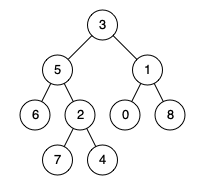1644. Lowest Common Ancestor of a Binary Tree II
1644. Lowest Common Ancestor of a Binary Tree II
Description
Difficulty: Medium
Related Topics: Tree, Depth-First Search, Binary Tree
Given the root of a binary tree, return the lowest common ancestor (LCA) of two given nodes, p and q. If either node p or q does not exist in the tree, return null. All values of the nodes in the tree are unique.
According to the definition of LCA on Wikipedia: “The lowest common ancestor of two nodes p and q in a binary tree T is the lowest node that has both p and q as descendants (where we allow a node to be a descendant of itself)”. A descendant of a node x is a node y that is on the path from node x to some leaf node.
Example 1:

1 | Input: root = [3,5,1,6,2,0,8,null,null,7,4], p = 5, q = 1 |
Example 2:

1 | Input: root = [3,5,1,6,2,0,8,null,null,7,4], p = 5, q = 4 |
Example 3:

1 | Input: root = [3,5,1,6,2,0,8,null,null,7,4], p = 5, q = 10 |
Constraints:
- The number of nodes in the tree is in the range [1, 104].
- -109 <= Node.val <= 109
- All
Node.valare unique. p != q
Follow up: Can you find the LCA traversing the tree, without checking nodes existence?
Hints/Notes
- 2023/08/29
- It’s possible that the nodes don’t exist, so we need to check every node, so it’s postorder traverse
- Leetcode solution
Solution
Language: C++
1 | /** |